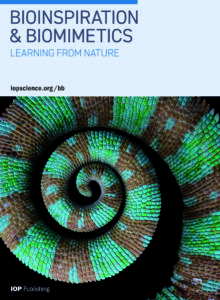BB特刊征稿|Focus Issue on Bioinspired Soft Aerial Robotics

特刊详情
客座编辑
- Sophie Armanini,英国帝国理工学院
- Pham Huy Nguyen,英国帝国理工学院
- Kevin Chen,美国麻省理工学院
- Pakpong Chirarattananon,香港城市大学
- Salua Hamaza,荷兰代尔夫特理工尔大学
- Stefano Mintchev,瑞士苏黎世联邦理工学院
- Mirko Kovac,英国帝国理工学院
主题范围

Flying bio-inspired aerial robot with dragonfly wings and continuum robot arms.
The burgeoning field of bioinspired soft aerial robotics holds great promise for revolutionizing aerial robotics by providing solutions to challenges previously unattainable with traditional rigid structures, making significant contributions in various real-world applications and ultimately improving the efficiency and safety of airborne robotic systems.
Currently, the thriving field of soft aerial robotics has seen advances in the development of airborne robotic systems through the utilization of deformable and flexible structures. Unlike conventional rigid-bodied aerial robots, soft aerial robots leverage compliance and morphing capabilities to achieve unique advantages in versatility, adaptability to various terrains, scalability, agility, maneuverability, manipulation, and multi-functionality in a single robot. In the last few years, we have seen work that ranged from novel design principles, real-world applications, bio-inspiration, and control and modelling principles for soft aerial robots.
The emphasis of this Focus Issue will be on the latest and greatest updates from groups working in this field, with a special emphasis on comparative biology. This sentiment has two folds, first to draw inspiration from biology for the development of the next generation of aerial vehicles and second is to develop robophysical models to help understand biology better. This could be roboticists contributing to further understanding biological flyers hand-in-hand with biologists by developing robophysical models or it could be further understanding morphological features of flying animals to enhance aerodynamic performance, adaptability to real-world environments, and expanding the functionalities of future flight systems.
This issue will explore current challenges, such as: (1) what are robophysical models and how to develop them to understand flight better; (2) multi-modal mobility between aerial, terrestrial, and aquatic environments; (3) robustness to landing and collision through structural adaptations; (4) adaptive manipulation and perching in aerial systems; (5) bio-inspired aerial construction and nesting; (6) bio-hybrid flying structures, biodegradability, and sustainable transient aerial robotics; (7) modelling and control of soft aerial robots; (8) soft sensing for aerial vehicles and morphing wings.
投稿流程
特刊文章与BB期刊常规文章遵循相同的审稿流程和内容标准,并采用同样的投稿模式。
有关准备文章及投稿的详细信息,可以参阅IOPscience页面的作者指南。
作者可登入期刊主页进行在线投稿,在“文章类型”中选择“特刊文章”,并在“选择特刊”的下拉框中选择“Focus Issue on Bioinspired Soft Aerial Robotics”。
投稿截止日期:2025年6月30日。
期刊介绍

- 2023年影响因子:3.1 Citescore:5.9
- Bioinspiration & Biomimetics(BB,《生物灵感和仿生学》)致力于借鉴生物学来丰富工程学,同时利用工程学来充实生物学。发表在BB上的研究专注于不断演变的生物系统的原理、功能及其应用,以此来开发新的技术和方法,解决科学问题。
